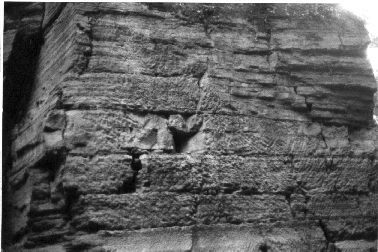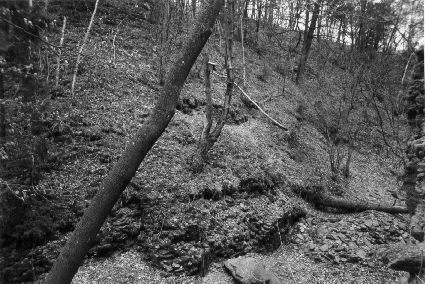Links to other Web-Sites
False interpretation by the official archeologists:
Despite of the facts, these sensational discoveries are put into question by responsible archeologists. They consider the laying-outs to be normal stonebreaks and the Cairns or "Hälden" are regarded as totally disproportioned rubble-heaps.
Dating:
Nethertheless the archeologists are not able to deny that this "stonebreaks", which are characteristically known by the same name of parcells "Hälde", are very old. Even the german word "Halde" = rubble heap derives from the german folk "Alemannen", which apears 260 A. D. The "Sommerhälde" of Schmie f. e. is presumed to deliver the building blocks to the nearby Cloister of Maulbronn in the 12th century. Also the "Alte Steinbruch" (= old stonebreak) in the "Kruschhälder Gebirge" at the village Sulzfeld is said to have been started in the 12th century - the time when the nearby castle "Ravensburg" was build. Actually there are forest-maps of the 13th century, which note these "Steingruben" (= stone-cavities) around Kürnbach. They are the oldest "stonebreaks" of the country.
The characteristics of this "stonebreaks" however point out to much older times. The walls in this "stonebreaks" are not rugged, but smooth, levelled by chissel or pickaxe. You can see it distinct in the "Zwerchhälde" of Sternenfels (picture 5).

picture 5: Zwerchhälde of Sternenfels, one of the smoothed rock-wallsThis kind of rock-work you will find exemplary in the "Kriemhildenstuhl" nearby Bad Dürkheim, a so-called stonebreak, which is said to be a roman stonebreak because of its roman incsripts . But there you will find petroglyphs, too, which the excavator Dr. Sprater compared in the 30ies of this century with those of the nordic bronze Age, conventionally dated between 3500 and 1200 B.C. But the surprising fact is that such chissel-levelled rock-walls are found above all and without exception in Pyramid-stonebreaks of Egypt. The raising of one of the oldest pyramids, the pyramid of Khufu, is dated back to the time of 2800 B. C. But the very queer ancle of the pyramid-sides of ~52o can only be constructed geometrically with the sevenstar, which is the remarkable symbol of the coat of arms of Sternenfels (look at the head-line).
Stonebreak-method:
This chissel-traces are the result of a very ancient stonebreak-method, which exists even before the time of drill-work and cracking. Long cuts were chisselled or picked in the rock in which they set wood-wedges. Water made them swell up and so the squares bursted off the rock. But in spite of the presume the Romans practised mainly drill-work and cracking.Stonebreak or sepulchre?
The difference between southgerman pyramids and those in Egypt, (apart from the smaller size of the squares and the buildings at all and the lower perfektion of the form), is above all that ours are raised at the place where the building blocks were produced, consequently in the stonebreak. Now you can see examplary at the three Pyramids of Gizah that the stonebreaks, too are located close to the monuments and that there are adits and galleries carved in the rock-walls. There is almost no stonebreak in Egypt which was not transformed subsequently to a rock-grave.Therefore you can conclude that due to the chissel-works they bear, german stonebreaks are older than the roman period, originally being determined as antique graveyards.Hälde - the very ancient name of stone-graves:
All of the cairns disvovered until today carry the name "Hälde". This leads to the conclusion that the german term "Halde" (= rubble heap) was the original name of these grave-pyramids. And the term really meant what the german word says, that is: a "Hälde" is a "Behältnis" (= holder). These "Hälden" holds something in it, one or more burial-chambers. That what superficially looks like an unproportional rubble-heap is in reality a buried and partially fallen in step-pyramid which was covered by bushes and trees during the ages.The constructional princips of cairns and pyramids:
Also, the constructional principles of these "Hälden"are similar to the Western-European cairns -consequently to the step-pyramids, too. They even equal the smooth king-pyramids of Egypt. What only a few people know: One step of a pyramid is not lying horizontally onto the adjoing one but forms a vertical mural structure. Any wall would annex to others like an onion-skin. In fact, there is a high tower in the centre of a pyramid which looks exactly like an obelisk. Here, the steps join like thick walls of descending height. The discoverer can show these constructional characteristics at the best-investigated "Hälde", the Zwerchhälde of Sternenfels (height 20 m, breadth 60 m, length 80 m) after the excavation (picture 6).

picture 6: Zwerchhälde of Sternenfels, the basic wall shows the beginning of a joined mural step, which is typical of brittanic and british cairns. Over it you can see the excavated wall of another step of the 20 m high edifice of sandstone-slabs. The total uncovering is not possible at the time, because there is danger of collapse. The monument has a weight of calculated 150.000 tons.
Appeal for support:
It is our sincere intention to find the entrance to this burial-chamber(s) deep under the gigantic masses of stone. The excavator has reached the bounds of practicability and for that reason he needs professional help. Extensive provisions during the excavations against tumbling down walls are absolutely necessary and above all there are tunnels to sink in search for the burial-chambers. For that we must use a totally new technology of exploration. With ultra-longwaves it is possible to detect hollow spaces even 30 meters deep under earth and stone. This technique results out of the secret US-submarine-communikation and passes all means of a private person. This project can only be realized by public authorities and/or universities.Who in german or in foreign universities or in the offices of conservation is willing to get convinced by a private seeker of this not riskless project?
Invitation for an inspection:
Interested private persons, journalists, students und bachelors of archeology are kindly invited to go and see for yourself. Make up your own mind! Critics and pessimists are invited as well to point out their attempts of interpretation.
Make your own dicision. Is it possible that anytime in history man was in need for piling up restlessly all the broken stones of a stonebreak immediately at the same place to obtain totally unprofitable heaps? Or did they pursue just the same as other people of the high-cultures- all at the same time, that is to erect monumental grave-buildings for the rulers of their countries?
The investigations are depending of any kind of support, not only materialistic but also idealistic, because we have to overwhealm a huge resistance and persistance by the conventionally thinking scientists.
Chronological new-estimation:
The men in this country may prefer to believe in the long-known and roman-delivered sketch of the stupid and brutal Germain rather than in historically quite possible pyramids. These seem to be built under a realistic view by the Celts. Not only the comparison of the necropole of Schmie with the etruskian tombs of Cerveteri suggests the same time- between 800 and 400 B. C. The Etrusks built burial-chambers with corbelstone-vaults still in 600 B- but with very old megalithic types of construction, dated conventinally in western and northern Europe between 5800 and 2200 B. C. And nearby Tressé, St. Malo, Ille-et-Vilaine in a megalithic galery-grave the corpse of a Celt was found with the typical attributions of the Hallstatt-time (750 B. C.) und other times up to the roman epoche. It is plain that something is wrong with our prehistoric chronology. Probably the big stone-graves of the megalithic-culture are not built in the late stone Age or in the bronze Age where no hard tools for hewing and facing were producible, but only at first in the iron Age which begins in Europa at ~800 B. C.Further informations:
The outcome of false datings and totally stretched chronological orders of prehistorical times is revealed by Heribert Illig in his quarterly appearing bulletin ZEITENSPRÜNGE which you can subscribe to at:MANTIS-Verlag
Lenbachstr. 2a
D-82166 GräfelfingThe Chronological theme is treated in Illig`s books:
"Die veraltete Vorzeit" (1988) and
"Wann lebten die Pharaonen" (1997).On the topics of celtic pyramids the excavator has written some unfortunately less regarded articles himself:
Literature:
Walter Haug -
- "Das Felsengrab des Keltenkaisers bei Sternenfels" in AKTION 6/91, Feb 92, Pforzheim Friedensstr. 101
- "Die Keltenpyramide bei Sternenfels" in AKTION Okt 92, Mär 93, Jun 93, Pforzheim Friedensstr. 101
- "Eine Pyramide in Deutschland?" in Magazin für Grenzwissenschaften 4/93, Plaidt Niederstr. 31
- "Keltische Megalithgräber in Süddeutschland?" in Zeitensprünge 4/95 Mantis Verlag, GräfelfingIn search for publishers:
Above all, an extending typoscript exists, including the documentation of the excavations, all of the photos and archeological comparisons, which is seeking for publishers on this way.Contact-adress:
- Walter Haug
- Wössinger Str. 100
- D-75045 Walzbachtal
- Tel. 07203/6278mail: starrocker@geocities.com